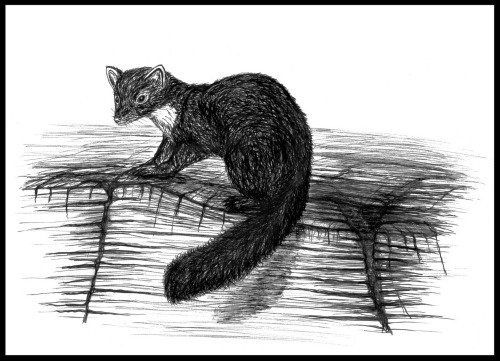
There are just 22 land mammals in Ireland excluding bats and seals. The smallish number is explained in part by Ireland’s island status, its small land area and its range of latitudes. It is worth pointing out also that we had more land mammals in the past including European brown bear, wolf, boar, reindeer, lemmings and Arctic fox. The latter are all now extinct here due to climate change, habitat destruction and/or persecution by man.
Only 3 of the 22 native land mammals we have today preceded the arrival of mankind in to Ireland. (The oldest evidence of mankind here is 12,500 years ago in the Palaeolithic era). They are the stoat, the otter and the hare. All the others have been introduced by humans.
The carnivora
order
of land mammals is dog-and cat-like. There are six members of the order evident
in the Burren –
badger ( Meles meles
), pine marten ( Martes martes
), stoat ( Mustela ermine
), fox ( Vulpes vulpes
), otter ( Lutra lutra
) and the invasive mink ( Mustela vison
).
The pine marten ( Martes martes
) is
Ireland’s most elusive land mammal. It is a beautiful animal with a dark brown
fur coat and a creamy-yellow throat patch. The marten has semi-retractable claws
which allows it to lead arboreal lifestyles. It’s long, bushy tail is
used for balance as it jumps from branch to branch. The pine marten is known as cat crainn
in Gaelic (tree cat).
The only native land mammals in Ireland today which precede the arrival of mankind are the stoat, the hare and the otter. These three are known as “early natives”. Pine martens were introduced by prehistoric mankind for fur and food (as were badgers, foxes, red squirrels, red deer and wild pigs).
The marten can be found in Scotland and Ireland but is absent from England and Wales. The Scottish population is about 3,000. The Irish population is most probably less. However, its numbers are on the increase. The Burren is an irish stronghold of the pine marten. Its numbers have increased here as the scrub and woodland have expanded in the hills with the farming decline.
A ground-breaking study in the Irish midlands has concluded that invasive grey squirrel populations decline drastically, (even to the point of eradication), in areas where there are pine martens, grey and red squirrels. The marten is a predator of squirrels and can much more readily prey on the grey as the latter is a ground-feeding animal. This is great news for conservationists as the native red has been declining all over Europe with the advance of the more robust grey.
It is planned to re-introduce the pine marten to England in 2019. The region chosen is the Forest of Dean in Gloucestershire. Numbers proposed are 40 to 60 animals in an area of 800 square kilometres. Martens like to live at low density and have only 2 to 3 kits each year. The re-introduction of the martens in the Forest of Dean may be followed by the re-introduction of the red squirrel.
Apart from grey squirrels, the marten’s diet includes invertebrates, birds’ egg and berries. The animal is not popular with most owners of gamebird and poultry pens. If the marten breaches the pens, it can cause havoc. If the pen owner uses the correct fencing and remains vigilant, the birds or poultry should be safe from the pine marten.
The line drawing is one of twenty excellent such sketches which feature in my book The Burren and the Aran Islands A Walking Guide (The Collins Press 2009). The artist is Barcelona man Carles Casasin. Carles has been living in Ballyvaughan for almost twenty years. He is a proud Catalan who also makes animation films. Visca Carles!
BIBLIOGRAPHY
Exploring Irish Mammals.
Tom Hayden and Rory Harrington. Townhouse Dublin. 2000.
Mind The Gap 2. New Insights into the Irish Postglacial
. Paddy Sleeman (Editor). Irish Naturalists Journal. 2014.



